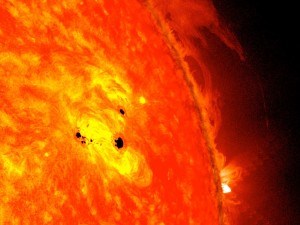
For those of you who dread the impending darkness brought on by the shorter days of fall and winter, fear not. There may be light on the horizon.
The solar cycle, also known as the sun spot cycle, continues to peak this fall, creating space weather that could bring with it the liveliest displays of northern lights seen in more than a decade.
Sunspots wax and wane on a fairly predictable 11-year cycle, although the cycle can vary from eight to 14 years. This is the 24th cycle since astronomers first began to record them in the mid 1700s, and it looks like this cycle might have the smallest number of sunspots since 1906.
Sunspots appear as dark spots on the sun’s surface, and are associated with eruptions of magnetic energy like solar winds (streams of charged particles), and flares.
Some of the brightest and most colourful aurorae are seen during intense eruptions like mass coronal ejections (CMEs). CMEs create huge bursts of solar wind and magnetic fields that rise above the sun’s corona, a plasma field that extends millions of kilometres from the sun’s surface.
Most CMEs originate in magnetically active regions around visible sunspots, which is why the frequency of these events increases toward the sun spot maximum.
When solar winds reach Earth, charged particles interact with its magnetic field (the magnetosphere). The particles are directed toward the magnetic poles, and this is why aurorae are most commonly seen over Earth’s polar regions. The extent of auroral activity is known as an “auroral oval.”
“If the auroral oval extends all the way down to Jasper, which it might a few times this fall, you’ll start to see the semi-solid curtains of light that folks in Yellowknife and the like often see,” said Peter McMahon, Jasper’s astronomy-writer-in-residence for the Jasper Dark Sky Festival. “If it’s not quite that far south, you’ll get more of a glow than concrete structures.”
McMahon said during rare solar activity, the auroral oval can descend as far south as the U.S., with faint aurorae visible as far south as Florida. However, he is quick to point out that it “almost never happens.”
Although the sunspot cycle is predicted to peak this fall or winter, there has already been some spectacular solar activity in 2013. On Feb. 19 and 20, two sunspots developed over a 24-hour period, and together were the size of six Earths across. On June 20, a CME erupted and caused a geomagnetic storm, funnelling energy into Earth’s magnetic field for an extended period of time. These storms are not harmful to people, but strong blasts can scramble communication systems on Earth, and cause surges in power grids.
Fortunately, according to the North American Space Administration (NASA), CMEs like the one released on June 20 are usually mild. However, they can still create some spectacular aurorae. Even better, it’s possible to know when the aurorae might occur.
Eruptions are monitored by a number of astronomical agencies, and since the solar winds from these eruptions take one to three days to hit Earth, it’s possible to know when good aurora viewing is heading our way. You can have alerts sent to your phone or inbox from www.aurorawatch.ca, and see where the auroral oval is today at www.spaceweather.com.
To learn more about the solar cycle and space activity in general, make sure you check out the Jasper Dark Sky Festival this October. In the meantime, keep your eye on the sky, and hope the auroras light up the nights in the coming months.
Niki Wilson
Special to the 51����
